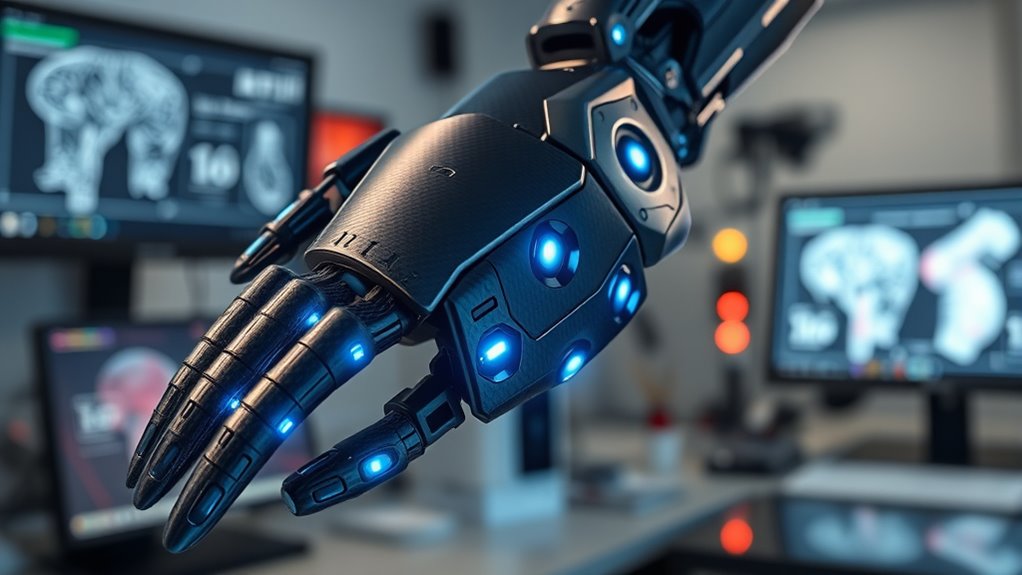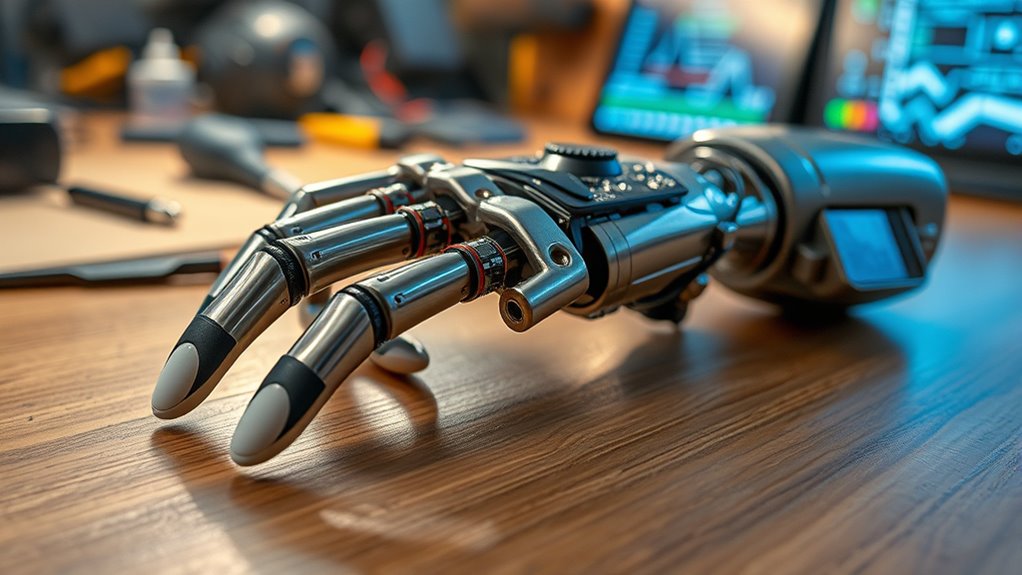AI is revolutionizing smart prosthetics by enabling devices that adapt to your needs with advanced algorithms like CNNs and machine learning. These systems process sensor data to improve movement, environmental awareness, and comfort. Neural interfaces interpret your brain signals for precise control, reducing effort. AI also helps personalize your device, ensuring it learns your preferences over time. As security is essential, ongoing efforts protect your data. Keep exploring to discover how these innovations can transform your independence and daily life.
Key Takeaways
- AI algorithms, especially CNNs and machine learning, enable advanced object recognition and environmental navigation in prosthetics.
- Embedded sensors and feedback loops allow prosthetics to adapt in real-time for improved stability and comfort.
- Neural interfaces powered by AI interpret neural signals, providing users with more natural, precise control over prosthetic movements.
- AI enhances security and privacy to protect sensitive neural and device data from cybersecurity threats.
- Personalization through AI allows prosthetics to learn user preferences and integrate with IoT devices for proactive support.

Have you ever wondered how artificial intelligence is transforming prosthetics from simple mechanical devices into intelligent, responsive extensions of the body? Today’s smart prosthetics leverage advanced AI algorithms, especially convolutional neural networks (CNNs), to process and interpret visual data. This allows them to handle objects more effectively and navigate complex environments with greater ease. By integrating neural AI algorithms, developers can tailor prosthetic devices to individual user needs, making them more intuitive and functional. Machine learning plays a vital role here, enabling prosthetics to learn from your movement patterns over time. The more you use them, the better they become at predicting your intentions, resulting in smoother, more natural movements during activities like walking, grasping, or climbing stairs.
AI-powered prosthetics constantly refine their performance through continuous learning. As they adapt to your unique biomechanics and activity levels, their responsiveness and precision improve, making everyday tasks easier and less cognitively demanding. Sensors embedded in these devices act as a prosthetic nervous system, collecting real-time data on movement, pressure, and environmental conditions. This data allows the prosthetic to automatically adjust, such as stabilizing when walking on uneven terrain or climbing stairs, guaranteeing ideal motion and comfort. The integration of sensor technology with AI creates a feedback loop that personalizes each prosthetic’s response, tailoring it to your specific needs and activity context. Sensor technology enhances the adaptability and responsiveness of these devices, making them more effective. Additionally, advancements in machine learning enable continuous improvements and customization based on user feedback. Furthermore, the development of neural interfaces is paving the way for even more seamless integration between the human nervous system and prosthetic devices.
AI-driven prosthetics learn and adapt in real time, enhancing comfort, precision, and personalized support through embedded sensors and intelligent feedback loops.
Beyond mechanical replacement, AI enables prosthetics to become truly responsive and intelligent. For instance, mind-controlled prosthetics utilize AI to interpret neural signals, giving you more voluntary control over the limb. This results in more precise movements for complex tasks—like gardening or sketching—reducing the effort needed to operate the device. Improved signal decoding and intuitive control systems lessen your cognitive load, making the use of a prosthetic feel more natural. As these systems evolve, they’ll continue to adapt to your changing needs, such as adjustments for fatigue or injury progression, enhancing long-term usability and comfort. Additionally, ongoing research into AI security is essential to ensure these sensitive systems remain protected from vulnerabilities that could compromise user safety. Cybersecurity measures are critical for safeguarding these advanced systems from potential threats, ensuring user trust and safety.
Personalization is at the core of AI-driven prosthetics. They learn your preferences and modify their behavior accordingly, whether you’re walking, running, or handling delicate objects. This adaptability guarantees a better fit and more comfortable experience over time. Future developments may also enable prosthetics to communicate with IoT devices, offering synchronized health monitoring and environmental awareness. Predictive analytics could anticipate your needs before you even express them, making these devices not just reactive but proactively supportive. In this way, AI is revolutionizing prosthetic technology, transforming it from a mechanical aid into an intelligent partner designed to enhance your independence and quality of life.
Frequently Asked Questions
How Affordable Are Ai-Powered Prosthetics for Most Patients?
You might wonder about the affordability of AI-powered prosthetics for most patients. Currently, these advanced devices are quite expensive due to high costs of sensors, microprocessors, and R&D. While they offer better mobility and personalized care, their price often limits access for many. As technology advances and production costs decrease, there’s hope that AI-powered prosthetics will become more affordable and accessible to a broader range of users in the future.
What Are the Ethical Considerations in Ai-Driven Prosthetic Development?
When considering ethical issues in developing AI-driven prosthetics, you need to focus on privacy, autonomy, and fairness. You should guarantee users control their data, prevent unauthorized access, and address potential biases that could limit access for disadvantaged groups. Balancing innovation with safety and inclusivity is essential. By prioritizing transparent policies and equitable access, you help create prosthetics that respect users’ rights and promote social justice.
How Long Does It Take to Develop a New Ai-Enabled Prosthetic?
Building a new AI-enabled prosthetic is like crafting a complex symphony, taking years to perfect. It typically involves several stages: research, design, testing, and regulatory approval, which can span from 5 to 10 years or more. Your team needs to develop advanced materials, integrate sensors, and fine-tune neural interfaces, all while ensuring safety and functionality. Patience and collaboration are key to creating innovations that truly change lives.
Can AI Adapt to Users’ Changing Needs Over Time?
Yes, AI can adapt to your changing needs over time. It uses predictive learning algorithms and real-time data analysis to observe your movements and environmental conditions. As you use the prosthetic, AI learns from your behavior, making adjustments for smoother, more natural interactions. With ongoing feedback and adaptive control systems, your prosthetic continuously improves, providing greater comfort, mobility, and independence as it responds effectively to your evolving requirements.
What Are the Main Challenges in Integrating AI With Existing Prosthetic Technology?
The main challenges in integrating AI with existing prosthetic technology are enormous, like trying to fit a spaceship into your pocket. You need sophisticated algorithms that mimic human movements perfectly, handle noisy neural signals, and offer natural sensory feedback. Plus, designing energy-efficient systems, ensuring long-term reliability, and making these devices affordable pose huge hurdles. Overcoming these issues requires breakthroughs in hardware, software, and healthcare collaboration.
Conclusion
As you explore the future of smart prosthetics, remember that AI has already improved mobility for over 80% of users. With ongoing advancements, you’ll see even more intuitive, personalized devices that seamlessly integrate with your body. Imagine a world where prosthetics adapt instantly to your movements, enhancing independence. The potential is incredible—AI’s role in this revolution is just beginning. Embrace the innovation, and you’ll be part of a transformative journey toward better quality of life.











